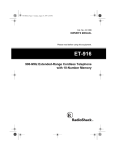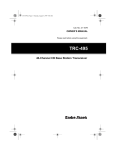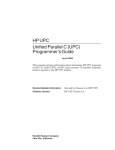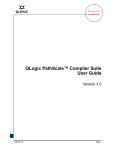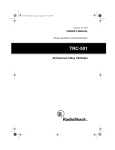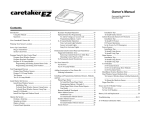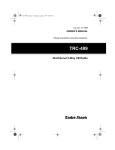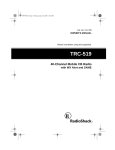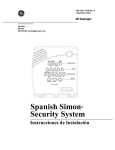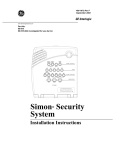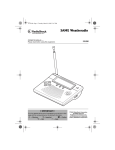Download Radio Shack TRC-498 Owner`s manual
Transcript
21-1598.fm Page 1 Thursday, August 5, 1999 10:52 AM Cat. No. 21-1598 OWNER’S MANUAL Please read before using this equipment. TRC-498 40-Channel CB Mobile Transceiver with Digital Signal Processor 21-1598.fm Page 2 Thursday, August 5, 1999 10:52 AM FEATURES Your RadioShack TRC-498 40Channel CB Mobile Transceiver is a breakthrough in CB design technology. It includes a DSP (Digital Signal Processor) circuit for improved audio quality, which reduces background noise and virtually eliminates the whines and whistles commonly heard on crowded CB frequencies. Emergency Channel Switch — lets you quickly switch to Channel 9 so you can monitor or report emergency situations. Your CB also has these advanced features: Base Station Capability — lets you use the transceiver as a base station powered from a standard AC outlet (with an optional power supply and base station antenna). DSP Switch and Indicator — turns the DSP circuit on and off and shows the on/off status of the circuit. Phase-Locked Loop (PLL) Frequency Synthesizer — provides highly accurate and stable tuning. Two Built-In Ceramic Filters — ensure superior channel selectivity and freedom from adjacent channel interference. Automatic Modulation Control — prevents the transmitter signal from over-modulating and distorting. Automatic Noise Limiter — reduces impulse-type noises while receiving. Large, Illuminated, Digital Display — clearly shows the channel number. Built-In PA (Public Address) Amplifier — lets you use your CB as a public address system when you add an optional PA speaker. RF Gain Control — lets you adjust the receiver gain to match the strength of the received signal. 4-Step RX Signal/TX Power Meter — shows the strength of the incoming and outgoing transmissions. External Speaker Jack — lets you connect your CB to an external speaker. Noise Reduction Switch — lets you select one of two available noise reduction modes. Universal Mounting Bracket — lets you mount your CB securely in your vehicle or on a table or shelf in your home. © 1996 Tandy Corporation. All Rights Reserved. RadioShack is a trademark used by Tandy Corporation. Powerhorn is a registered trademark used by Tandy Corporation. 2 21-1598.fm Page 3 Thursday, August 5, 1999 10:52 AM Note: To use this CB, you must connect a mobile or base station antenna. Your local RadioShack store has a wide variety of antennas. For more information, see “Connecting an Antenna” on Page 6. We recommend you record your CB’s serial number here. The number is on the CB’s back panel. Serial Number _________________ FCC INFORMATION The Federal Communications Commission (FCC) does not require you to have a license to operate this CB radio. However, you must know Part 95 of FCC Rules. It explains the proper operation of a Class D citizen’s band transceiver. We enclosed a copy of Part 95 with your CB radio. Warning: Do not open the CB radio to make any internal adjustments. A CB radio is set up to transmit a regulated signal on an assigned frequency. It is against the law to alter or adjust the settings inside the unit to exceed these limitations. To be safe and sure: • Never open your CB radio’s case. • Never change or replace anything in your CB radio. Your CB radio might cause TV or radio interference even when it is operating properly. To determine whether your CB radio is causing the interference, turn off your CB radio. If the interference goes away, your CB radio is causing it. Try to eliminate the interference by: • Moving your CB radio away from the receiver • Contacting your local RadioShack store for help If you cannot eliminate the interference, the FCC requires that you stop using your CB radio. This device complies with Part 15 of FCC Rules. Operation is subject to the following two conditions: (1) this device may not cause harmful interference, and (2) this device must accept any interference received, including interference that may cause undesired operation. Any adjustments to a CB radio must be made by a qualified technician using the proper test equipment. 3 21-1598.fm Page 4 Thursday, August 5, 1999 10:52 AM CONTENTS Installation ............................................................................................................ Attaching the Microphone Holder .................................................................... Mounting the Transceiver ................................................................................ Connecting an Antenna ................................................................................... Connecting the Microphone ............................................................................. Connecting Optional Speakers ........................................................................ Using an External CB Speaker ................................................................. Connecting a PA Speaker ......................................................................... Using Vehicle Battery Power ........................................................................... Using the Transceiver as a Base Station ......................................................... 5 5 5 6 7 8 8 8 9 9 Operation ............................................................................................................ Receiving Transmissions and Adjusting Squelch .......................................... Transmitting ................................................................................................... Using the Digital Signal Processor ................................................................ Selecting the Emergency Channel ................................................................ Using the PA Amplifier ................................................................................... 11 11 12 13 13 14 Operational Hints ............................................................................................... Common Uses for a CB ................................................................................. Personal Uses ......................................................................................... Business Uses ........................................................................................ Maximum Range ........................................................................................... Transmission Courtesy .................................................................................. Using Common 10-Codes ............................................................................. 15 15 15 15 16 16 17 Troubleshooting ................................................................................................. 18 Reducing Noise ............................................................................................. 20 Care and Maintenance ....................................................................................... 21 Replacing the Fuse ........................................................................................ 22 Specifications ..................................................................................................... 23 4 21-1598.fm Page 5 Thursday, August 5, 1999 10:52 AM INSTALLATION ATTACHING THE MICROPHONE HOLDER You can connect the microphone holder to either side of the transceiver or to another location in your vehicle. To attach the holder to either side of the transceiver, secure the holder to the side using the supplied screws and lock washers. Note: If you cannot reach behind the mounting surface to attach the nuts on the machine screws, use the supplied 3 mm plain washers and self-tapping screws. MOUNTING THE TRANSCEIVER To attach the holder to another location in the vehicle, such as the dashboard, follow these steps. 1. Using the holder as a template, mark the positions for the mounting screw holes at the desired location. 2. At each marked position, drill a hole slightly smaller than the supplied mounting screws. Caution: Be careful not to drill into anything behind the mounting surface. 3. Attach the holder at the mounting location using the supplied 3 mm machine screws, spring washers, plain washers, and nuts. The most common mounting location for this CB is under a vehicle’s dashboard. However, if you use the TRC498 as a base station, you can place it on a desk, shelf, or table (see “Using the Transceiver as a Base Station” on Page 9). If you are mounting the CB in a vehicle, choose a location where: • You can easily reach the CB. • Wires and cables are clear of the vehicle’s pedals or other moving parts. • The CB is not directly in front of heating vents. • All wires and cables can reach their connection points. 5 21-1598.fm Page 6 Thursday, August 5, 1999 10:52 AM Caution: If you use the CB in a vehicle, mount it securely to avoid damage to the CB or vehicle or injury to anyone in the vehicle during sudden starts or stops. Follow these steps to mount the CB using the supplied hardware. nuts on the bolts, use the supplied 6 mm self-tapping screws and plain washers to secure the bracket. 4. Attach the CB to the mounting bracket using the supplied rubber washers and mounting knobs. 1. Using the mounting bracket as a template, mark the positions for the screw holes on the mounting surface. CONNECTING AN ANTENNA 2. In each marked location, drill a hole slightly smaller than the supplied mounting screws. Caution: Be careful not to drill into objects behind the mounting surface. 3. Mount the bracket to the mounting surface with the supplied 6 mm bolts, spring washers, plain washers, and nuts. There are many different types of CB antennas for mobile CBs. Each type has its own benefits, so choose the one that best meets your needs. Your local RadioShack store sells a wide variety of antennas. Note: If you are using this CB as a base station, see “Using the Transceiver as a Base Station” on Page 9. When you choose an antenna, keep in mind that, for the best performance, you should mount the antenna: • As high as possible on the vehicle • As far as possible from sources of electrical noise • Vertically Note: If you cannot reach behind the mounting surface to attach the 6 21-1598.fm Page 7 Thursday, August 5, 1999 10:52 AM Once you choose an antenna, follow its mounting instructions. Then route the cable to the transceiver and connect the cable to the ANT jack on the back of the transceiver. CONNECTING THE MICROPHONE 1. Press the tab on the side of the supplied microphone’s plug and insert the plug into the microphone jack on the side of the transceiver. Be sure the tab is aligned with the jack’s notch. To Antenna Cautions: • Avoid routing the cable next to sharp edges or moving parts, which might damage the cable. • Do not run the cable next to power cables or other radio antenna cables. 2. Slide the microphone onto the microphone holder. • Do not run the cable through the engine compartment or other areas that produce extreme heat. To achieve your radio’s maximum range, adjust the antenna’s Standing Wave Ratio (SWR) using an SWR meter (not supplied). Follow the instructions supplied with the SWR meter and antenna to adjust your antenna’s SWR to the lowest possible value. SWR values of 2.0:1 are generally acceptable, with readings of 1.5:1 or lower being more desirable. Caution: To disconnect the microphone from the transceiver, press the tab on the side of the plug. Then pull out the plug. Never pull on the microphone cable. 7 21-1598.fm Page 8 Thursday, August 5, 1999 10:52 AM CONNECTING OPTIONAL SPEAKERS You can connect your transceiver to an external CB speaker and/or a PA (public address) speaker. Note: When you connect an external or PA speaker, the CB’s internal speaker disconnects. Using an External CB Speaker The external speaker you use with the transceiver should have an impedance of 8 ohms and be able to handle 3 to 10 watts of power, such as RadioShack Cat. No. 21-549. The speaker cable must have a 1/8-inch plug. To connect the external speaker to the transceiver, insert the speaker cable’s plug into the EXT SPKR jack on the back of the CB. Connecting a PA Speaker The PA speaker should have an impedance of 8 ohms and be able to handle at least 5 watts of power, such as any of the RadioShack Powerhorn® series speakers. The speaker cable must have a 1/8-inch plug. If your PA speaker does not already have a 1/8-inch plug, we recommend connecting the PA speaker with a phono plug-to-wire cable, available at your local RadioShack store. To connect the PA speaker to the transceiver, insert the speaker cable’s plug into the PA SPKR jack on the back of the CB. Power Connections To an 8-ohm, 5-Watt or Greater Speaker Power Connections To an 8-ohm, 3- to 10-Watt Speaker 8 Note: The speaker should be at least 6 feet from the CB. 21-1598.fm Page 9 Thursday, August 5, 1999 10:52 AM USING VEHICLE BATTERY POWER Follow these steps to connect the transceiver to vehicle battery power. USING THE TRANSCEIVER AS A BASE STATION Although this transceiver is designed mainly for mobile use, you can also use it as a base station with an AC power source. For base station installation, you need these items: Red Wire to Switched Accessory Terminal Black Wire to Ground 1. Connect the red wire (with the inline fuse holder) on the back of the transceiver to a point in your vehicle’s fuse block that has power only when the ignition is in the ACC (accessory) or ON position. 2. Connect the black wire to a metal part of the vehicle’s frame (chassis ground). Caution: Do not connect the black wire to a non-metallic (plastic) part, or to any part insulated from the vehicle’s chassis by a non-metallic part. • 12-volt DC power supply that can supply at least 1.5 amps (such as Cat. No. 22-120) Caution: Most 12-volt DC power supplies plug into a standard AC outlet to produce DC power. Before connecting your CB to a 12-volt DC power supply, read and follow the instructions included with the power supply. • Base station antenna (such as Cat. No. 21-967) • Coaxial antenna cable and connectors Note: Your local RadioShack store carries coaxial antenna cable and connectors. 9 21-1598.fm Page 10 Thursday, August 5, 1999 10:52 AM Follow these steps to install the CB as a base station. 3. Connect the transceiver’s black power wire to the negative (–) terminal on the DC power supply. 4. Connect the transceiver’s red wire (with the in-line fuse) to the positive (+) terminal on the DC power supply. Antenna Black Wire to Negative Terminal of DC Power Supply Red Wire to Positive Terminal of DC Power Supply 1. Mount the base station antenna as described in its owner’s manual. Warning: Use extreme caution when you install or remove a base station CB antenna. If the antenna starts to fall, let it go. It could contact overhead power lines. If the antenna touches a power line, contact with the antenna, mast, cable, or guy wires can cause electrocution and death. Call the power company to remove the antenna. Do not attempt to do so yourself. 2. Connect the antenna to the ANT jack on the back of the CB. 10 5. Connect the DC power supply to a standard AC outlet. 21-1598.fm Page 11 Thursday, August 5, 1999 10:52 AM OPERATION Caution: To prevent damage to the CB, be sure you connect an antenna and the microphone before you use the CB. Before you use your CB, you should know how to use it effectively and courteously. “Operational Hints” contains information that will help you get more enjoyment from your CB. 5. Set OUT/CH9 to OUT to select a channel other than Channel 9 (the emergency channel). RECEIVING TRANSMISSIONS AND ADJUSTING SQUELCH 1. Set CB/PA to CB. 2. Turn SQUELCH fully counterclockwise. 3. Turn RF GAIN fully clockwise. 6. Rotate the channel selector until the display shows the desired channel. 7. Adjust VOLUME to a comfortable listening level. 8. To cut out background noise between transmissions, wait until there is no signal, then slowly turn SQUELCH clockwise until the background noise stops. 4. Turn on the transceiver by turning VOLUME clockwise until it clicks. The channel display lights and the channel appears. 11 21-1598.fm Page 12 Thursday, August 5, 1999 10:52 AM Note: To receive very weak signals, turn SQUELCH counterclockwise. You hear noise between transmissions, but you also hear weak transmissions (those not strong enough to break through a higher squelch setting). 9. When the transceiver receives a signal, the RX SIGNAL indicators light. If the received signal is distorted, decrease the overall signal level by rotating RF GAIN counterclockwise. TRANSMITTING Note: We recommend you try receiving before you transmit. 1. Follow Steps 1–7 in “Receiving Transmissions and Adjusting Squelch.” 2. To transmit, press the talk button on the microphone. Hold the microphone 2–3 inches from your mouth and speak in a normal tone of voice, then release the talk button. The TX POWER meter lights. 10. Set the noise reduction switch to the proper setting to eliminate the type of noise you are hearing. NR — to reduce background noise TR — to eliminate tones, hetero- dynes, whistles, and whines Notes: 11. To turn off the CB, turn VOLUME counterclockwise until you hear it click. The display and indicators turn off. 12 • Usually, all four LEDs light. If fewer than four light, you might have a weak power source or improper power or antenna connections. 21-1598.fm Page 13 Thursday, August 5, 1999 10:52 AM • The MOD (modulation) light flickers as you speak. If the indicator lights continuously, you are speaking too loudly. If it lights dimly, you might be speaking too softly. MOD 3. To turn off the CB, turn VOLUME counterclockwise until you hear it click. The display and indicators turn off. SELECTING THE EMERGENCY CHANNEL Important: Channel 9 is reserved for motorist assistance and for reporting emergency information about accidents, hazardous road conditions, and so on. Always give emergency messages priority on Channel 9. To select the emergency channel (Channel 9), set OUT/CH9 to CH9. 9 flashes on the display, and the transceiver stays on Channel 9. USING THE DIGITAL SIGNAL PROCESSOR The DSP circuit eliminates steady tones or squeals and reduces noise in the voice band. To activate the DSP circuit, press DSP. The DSP indicator lights. Note: You can also select Channel 9 using the rotary selector when OUT/ CH9 is set to OUT. 9 still appears on the display, but it does not flash. To select another channel, set OUT/ CH9 to OUT. The previously selected channel number appears on the display. Note: The DSP circuit works only while receiving transmissions. To deactivate the DSP circuit, press DSP again. The DSP indicator turns off. 13 21-1598.fm Page 14 Thursday, August 5, 1999 10:52 AM USING THE PA AMPLIFIER Your CB has a built-in PA (public address) amplifier. With an optional PA speaker, you can turn your radio into a mobile public address system. Follow these steps to use the PA amplifier after you connect an external PA speaker (see “Connecting a PA Speaker” on Page 8). 1. Turn on the transceiver. Then set CB/PA to PA. PA appears on the display. CB PA 2. To transmit, press the talk button on the microphone. Hold the microphone 2–3 inches from your mouth and speak in a normal tone of voice. 3. Turn VOLUME for the desired volume level. If you hear a highpitched squeal, adjust VOLUME until the squeal stops. Note: The speaker should be at least 6 feet from the CB. 14 4. To end PA operation, turn the transceiver off. Or, set CB/PA to CB for CB communication. 21-1598.fm Page 15 Thursday, August 5, 1999 10:52 AM OPERATIONAL HINTS Like most activities, CB radio has its customs and courtesies. The following tips will help you get the most enjoyment from your CB. COMMON USES FOR A CB Personal Uses • Keep in touch with home while driving to work, to the store, or to a social activity. Let your family know you are tied up in traffic or that you will stop by the store on the way home. Business Uses • For security officers, a CB is more than a convenience — it is a must for both safety and efficiency. • Truck drivers and delivery personnel can learn road and traffic conditions and get assistance in locating destinations. A CB radio is also good company on those “long hauls.” • On construction crews, a CB radio quickly pays for itself when you are calling for additional materials or coordinating the activities of different work crews. • If you are a two-car (or more) family, CB radios are great for communicating with family members while they are in their cars. • Contact friends or neighbors — find out “what’s happening” or plan a get-together. • Ever have car trouble or run out of gas on the highway? What an assurance it is to be able to radio for assistance! • Camping, fishing, and other sports are more fun with a CB radio. Locate a buddy or find out “what’s cooking” back at camp. 15 21-1598.fm Page 16 Thursday, August 5, 1999 10:52 AM MAXIMUM RANGE The maximum range and quality of CB radio transmissions vary depending on the following conditions: • The type and quality of antenna used • The height of the antenna’s mounting location — the higher the antenna, the better the signal’s range • The surrounding terrain — mountains and tall buildings limit the range • Weather conditions • The number of nearby radios operating on the same channel • Standing wave ratio (SWR) between the antenna and the CB. Note: Your CB radio’s transmission range is generally line-of-sight. 16 TRANSMISSION COURTESY Please follow these guidelines of radio courtesy when using your CB. • Wait for a pause in someone else’s transmission before you ask for a break. • If you do not receive an answer to your call after a second attempt, sign off and wait several minutes before trying again. • Do not hold down the Talk button when you are not talking. (This is called dead keying.) • Assist callers with directions, information about road conditions, and any other reasonable requests. 21-1598.fm Page 17 Thursday, August 5, 1999 10:52 AM USING COMMON 10-CODES Citizen’s band operators and CB radio users have largely adopted the 10-codes for standard questions and answers. These codes permit faster communication and better intelligibility in noisy areas. This table lists codes adopted by the Associated Public-Safety Communications Officers (APCO). Code Meaning Code Meaning 10-1 Your signal is bad. 10-17 En route. 10-2 Your signal is good. 10-18 Urgent. 10-3 Stop transmitting. 10-19 Contact _____. 10-4 Message received and understood. 10-20 What is your location? 10-21 Call _____ by telephone. 10-5 Relay information to _____. 10-22 Cancel last message. 10-6 I am busy or are you busy? 10-23 Arrived at the scene. 10-7 Out of service. 10-24 Assignment complete. 10-8 In service. 10-25 Meet _____. 10-9 Repeat last message. 10-10 Negative (NO). 10-26 Estimated time of arrival is _____. 10-11 _____ in service. 10-30 Use caution. 10-12 Stand by. 10-31 Pick up. 10-13 Report road/weather conditions. 10-33 Emergency traffic. Clear the channel. 10-14 Information. 10-34 What time is it? 10-15 Message delivered. 10-41 Switch to Channel xx. 10-16 Reply to message. 10-62 Cannot understand. 17 21-1598.fm Page 18 Thursday, August 5, 1999 10:52 AM TROUBLESHOOTING If at any time you suspect that your CB is not working as it should, refer to the following chart to see if you can eliminate the problem. If these solutions do not solve the problem, do not attempt repairs or adjustment yourself. The CB should be serviced only by a qualified radio technician. If you still have problems, take your CB to a local RadioShack store for assistance. Symptom Solution Turn transceiver power on. Microphone connected? Secure connections. Antenna connected? Secure connections. Too much squelch? Adjust as needed. CB has trouble receiving. Radio not on operating channel? Switch to active channel. Set CB/PA to CB. Adjust VOLUME. Adjust RF GAIN. Turn transceiver power on. Antenna connected? Secure connections. All connections free of corrosion? Clean and tighten. CB has trouble transmitting. Microphone connector loose? Firmly press in jack. Set CB/PA to CB. Radio not on operating channel? Switch to an active channel. Talk button fully pressed in? Press completely. 18 21-1598.fm Page 19 Thursday, August 5, 1999 10:52 AM Symptom Solution Power connected? Secure connections. Radio does not work at all. Microphone connected? Secure connections. Fuse needs replacing? Replace with identical fuse. See “Replacing the Fuse” on Page 22. Set CB/PA to CB. Cannot select a channel. Set OUT/CH9 to OUT. Talk button fully pressed in? Press completely. Connect a PA speaker. Secure connections. PA does not work. Set CB/PA to PA. Adjust VOLUME. Adjust RF GAIN. Sound is distorted. Set the noise reduction switch to NR or TR. Adjust VOLUME. 19 21-1598.fm Page 20 Thursday, August 5, 1999 10:52 AM REDUCING NOISE Because your CB is exceptionally quiet, any noise you hear is probably from an external source in your vehicle such as the alternator, another radio or spark plugs. The transceiver uses an ANL (Automatic Noise Limiter) circuit and a DSP (Digital Sound Processor) circuit to reduce noise. However, if possible, try to eliminate the noise by finding its source. You can determine the noise’s source by turning off the engine and operating the CB with your vehicle’s ignition set to ACC. If the noise is reduced, the problem is in your vehicle’s ignition or electrical system. Here are a few hints to help you reduce or eliminate such noise: • Make all CB power and antenna wires as short as possible. • Route the power wires away from the antenna wires. • Be sure that the chassis ground connection is secure. • Replace old ignition wires with new, high-voltage, noise suppression wires. • Install noise suppressors on your spark plugs, or install new spark plugs that have built-in noise suppressors. 20 • If problems persist, check your alternator/generator and regulator gauges. You can reduce the noise from these sources by using bypass capacitors at the various output voltage points. Your local RadioShack store has a wide selection of noise suppression accessories. 21-1598.fm Page 21 Thursday, August 5, 1999 10:52 AM CARE AND MAINTENANCE Your RadioShack TRC-498 40-Channel CB Mobile Transceiver is an example of superior design and craftsmanship. The following suggestions will help you care for your CB so you can enjoy it for years. Keep the CB dry. If it gets wet, wipe it dry immediately. Liquids can contain minerals that can corrode electronic circuits. Handle the CB gently and carefully. Dropping it can damage circuit boards and cases and can cause the CB to work improperly. Use and store the CB in normal temperature environments. Temperature extremes can shorten the life of electronic devices, damage batteries, and distort or melt plastic parts. Keep the CB away from dust and dirt, which can cause premature wear of parts. CLEANER Wipe the CB with a damp cloth occasionally to keep it looking new. Do not use harsh chemicals, cleaning solvents, or strong detergents to clean the CB. Modifying or tampering with the CB’s internal components can cause a malfunction and might invalidate its warranty and void your FCC authorization to operate it. If your CB is not performing as it should, take it to your local RadioShack store for assistance. 21 21-1598.fm Page 22 Thursday, August 5, 1999 10:52 AM REPLACING THE FUSE The TRC-498’s 2-amp in-line fuse helps protect your CB from power surges and short circuits. When replacement is required, use a 2-amp, slow-blow glass fuse, such as Cat. No. 270-1023. Follow these steps to replace the fuse. 1. Make sure the power source and CB are both off. 2. Hold the fuse holder by both ends, push the ends together, twist one end counterclockwise, then pull them apart. 3. Remove the old fuse and inspect its condition. If it is blown and requires replacement, insert a new one of the same type and rating. If it is not blown, reinsert it. 4. Push the fuse holder ends together and twist one end clockwise. 22 21-1598.fm Page 23 Thursday, August 5, 1999 10:52 AM SPECIFICATIONS RECEIVER Frequency Coverage ................All 40 CB Channels (Class D) 26.965–27.405 MHz Sensitivity for 10dB S/N ................................................................................ 0.5 mV Squelch Sensitivity at Tight ........................................................................1000 mV Overall Audio Fidelity for 450–2500 Hz .......................................................... –6 dB Maximum Audio Output Power .................................................................... 6 Watts Cross Modulation ............................................................................................ 50 dB RF Gain Control Range (at 10 dB Input) ........................................................ 45 dB TRANSMITTER Frequency Coverage ................All 40 CB Channels (Class D) 26.965–27.405 MHz Frequency Tolerance .................................................................................. ±100 Hz Carrier Power at No Modulation ............................................................... 3.9 Watts Spurious Emission ........................................................................................ –70 dB Current Drain at No Modulation ................................................................. 1100 mA Modulation Frequency Response for 450–2500 Hz ....................................... –6 dB Microphone Sensitivity for 50% Modulation ..................................................... 1 mV PUBLIC ADDRESS AMPLIFIER Maximum Output Power .............................................................................. 6 Watts Microphone Sensitivity for 4 Watts Output Power ........................................... 3 mV Frequency Response for 450–2500 Hz .......................................................... –6 dB Current Drain at Maximum Output Power ..................................................1000 mA DSP NOISE REDUCTION Background Noise Reduction ..................................................................... 6–12 dB Tone Attenuation for 450–2500 Hz ................................................................. 25 dB GENERAL Power Requirements ................... 12 Volts DC, Negative Ground/120 V DC, 60 Hz Dimensions (HWD) ........................... 15/8 ¥ 59/16 ¥ 83/8 inches (42 ¥ 141 ¥ 213 mm) Weight ............................................................................................. 2 lb 3 oz (1 kg) Included Accessories .................................. Microphone Hanger, Mounting Bracket Specifications are typical, individual units might vary. Specifications are subject to change and improvement without notice. 23 21-1598.fm Page 24 Thursday, August 5, 1999 10:52 AM RadioShack Limited Warranty This product is warranted against defects for 90 days from date of purchase from RadioShack company-owned stores and authorized RadioShack franchisees and dealers. Within this period, we will repair it without charge for parts and labor. Simply bring your RadioShack sales slip as proof of purchase date to any RadioShack store. Warranty does not cover transportation costs. Nor does it cover a product subjected to misuse or accidental damage. EXCEPT AS PROVIDED HEREIN, RadioShack MAKES NO EXPRESS WARRANTIES AND ANY IMPLIED WARRANTIES ARE LIMITED IN DURATION TO THE DURATION OF THE WRITTEN LIMITED WARRANTIES CONTAINED HEREIN. Some states do not permit limitation or exclusion of implied warranties; therefore, the aforesaid limitation(s) or exclusion(s) may not apply to the purchaser. This warranty gives you specific legal rights and you may also have other rights which vary from state to state. We Service What We Sell 10/95 RadioShack A Division of Tandy Corporation Fort Worth, Texas 76102 7A6 811080500A Printed in China
























